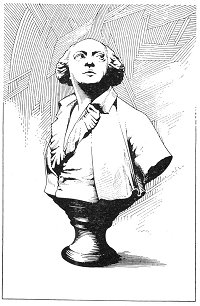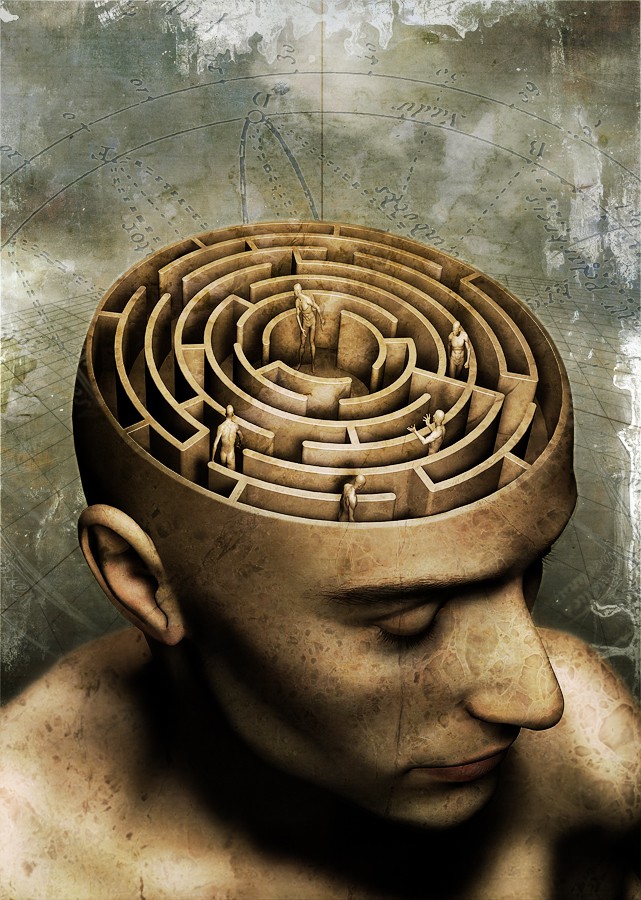The Comte de St.-Germain has been generally regarded as an important figure in early activities of the Freemasons. Repeated efforts, however, probably with an ulterior motive, have been made to discredit his Masonic affiliations. An example of this is the account appearing in The Secret Tradition in Freemasonry, by Arthur Edward
THE ”DIVINE” CAGLIOSTRO.
From Houdon’s Bust of Cagliostro. The Comte di Cagliostro is described as a man not overly tall, but square shouldered and deep of chest. His head, which was large, was abundantly covered with black hair combed back from his broad and noble forehead. His eyes were black and very brilliant, and when he spoke with great feeling upon some profound subject the pupils dilated, his eyebrows rose, and he shook his head like a maned lion. His hands and feet were small–an indication of noble birth–and his whole bearing was one of dignity and studiousness. He was filled with energy, and could accomplish a prodigious amount of work. He dressed somewhat fantastically, gave so freely from an inexhaustible purse that he received the title of “Father of the Poor,” accepted nothing from anyone, and maintained himself in magnificence in a combined temple and palace in the Rue d, la Sourdière. According to his own statement he was initiated into the Mysteries by none other than the Comte de St.-Germain. He had traveled through all parts of the world, and in the ruins of ancient Babylon and Nineveh had discovered wise men who understood all the secrets of human life.
p. 200
[paragraph continues] Waite. This author, after making several rather disparaging remarks on the subject, amplifies his article by reproducing an engraving of the wrong Comte de St.-Germain, apparently being unable to distinguish between the great illuminist and the French general. It will yet be established beyond all doubt that the Comte de St.-Germain was both a Mason and a Templar; in fact the memoirs of Cagliostro contain a direct statement of his initiation into the order of the Knights Templars at the hands of St.-Germain. Many of the illustrious personages with whom the Comte de St.-Germain associated were high Masons, and sufficient memoranda have been preserved concerning the discussions which they held to prove that he was a master of Freemasonic lore. It is also reasonably certain that he was connected with the Rosicrucians–possibly having been the actual head of that order.
The Comte de St.-Germain was thoroughly conversant with the principles of Oriental esotericism. He practiced the Eastern system of meditation and concentration, upon several occasions having been seen seated with his feet crossed and hands folded in the posture of a Hindu Buddha. He had a retreat in the heart of the Himalayas to which he retired periodically from the world. On one occasion he declared that he would remain in India for eighty-five years and then would return to the scene of his European labors. At various times he admitted that he was obeying the orders of a power higher and greater than himself. What he did not say was that this superior power was the Mystery school which had sent him into the world to accomplish a definite mission. The Comte de St.-Germain and Sir Francis Bacon are the two greatest emissaries sent into the world by the Secret Brotherhood in the last thousand years.
E. Francis Udny, a Theosophical writer, is of the belief that the Comte de St.-Germain was not the son of Prince Rákóczy of Transylvania, but because of his age could have been none other than the prince himself, who was known to be of a deep philosophic and mystic nature. The same writer believes the Comte de St.-Germain passed through the “philosophic death” as Francis Bacon in 1626, as François Rákóczy in 1735, and as Comte de St.-Germain in 1784. He also feels that the Comte de St.-Germain was the famous Comte de Gabalis, and as Count Hompesch was the last Grand Master of the Knights of Malta. It is well known that many members of the European secret societies have feigned death for various purposes. Marshal Ney, a member of the Society of Unknown Philosophers, escaped the firing squad and under the name of Peter Stuart Ney lived and taught school for over thirty years in North Carolina. On his deathbed, P. S. Ney told Doctor Locke, the attending physician, that he was Marshal Ney of France.

Moe is the founder of GnosticWarrior.com. He is a father, husband, author, martial arts black belt, and an expert in Gnosticism, the occult, and esotericism.


![How Augustine admonished the bishops of the Britons on behalf of Catholic peace, and to that end wrought a heavenly miracle in their presence; and of the vengeance that pursued them for their contempt [Circ. 603 A.D.] | Book 2 | Chapter 2 How Augustine admonished the bishops of the Britons on behalf of Catholic peace, and to that end wrought a heavenly miracle in their presence; and of the vengeance that pursued them for their contempt [Circ. 603 A.D.] | Book 2 | Chapter 2](https://www.gnosticwarrior.com/wp-content/plugins/contextual-related-posts/default.png)
